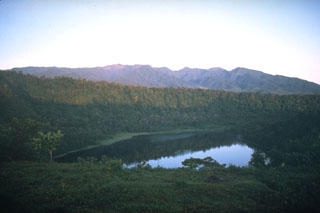Report on Platanar (Costa Rica) — March 1997
Bulletin of the Global Volcanism Network, vol. 22, no. 3 (March 1997)
Managing Editor: Richard Wunderman.
Platanar (Costa Rica) Dormancy continues but S-flank residents felt six earthquakes on 30 March
Please cite this report as:
Global Volcanism Program, 1997. Report on Platanar (Costa Rica) (Wunderman, R., ed.). Bulletin of the Global Volcanism Network, 22:3. Smithsonian Institution. https://doi.org/10.5479/si.GVP.BGVN199703-345034
Platanar
Costa Rica
10.3°N, 84.366°W; summit elev. 2267 m
All times are local (unless otherwise noted)
On 30 March 1997 residents in the S-flank settlement of San Vicente felt about six earthquakes between 0900 and 2100. One of these earthquakes took place at 1429; it was M 2.7 and its epicenter was 5 km SE of the volcano. No residents in other nearby settlements (Porvenir, Sucre, and Quesada) reported feeling these earthquakes.
About 10 days after the earthquakes, two dry-tiltmeters, measured every 2-3 years, showed differing results. One showed great changes but had been disturbed; the other, which was considered more reliable, had changed little. An April 1980 seismic swarm near Platanar, attributed to a local fault, continued for 2-3 weeks.
Geological Summary. The Platanar volcanic center is the NW-most volcano in the Cordillera Central of Costa Rica. The massive complex covers about 900 km2 and is dominated by two largely Pleistocene stratovolcanoes, Platanar and Porvenir. These volcanoes were constructed within the Pleistocene Chocosuela caldera, which may have formed during a major slope failure. The Cerro Platanar volcano (known locally as Volcán Congo) on the N side of the complex has prehistorical lava flows on its W flanks and is the youngest volcanic center. The highest peak is Porvenir, whose summit crater lies 3 km S of Platanar. A thin layer of phreatic ash suggested that an eruption from Platanar occurred within the past few thousand years (Stine and Banks, 1991). The Aguas Zarcas group of nine basaltic cinder cones, located on the N flank of the Platanar-Porvenir complex to as low as 160 m altitude is, in part, Holocene in age.
Information Contacts: E. Fernández, E. Duarte, V. Barboza, R. Van der Laat, E. Hernandez, M. Martinez, and R. Sáenz, Observatorio Vulcanológico y Sismológico de Costa Rica, Universidad Nacional (OVSICORI-UNA), Apartado 86, 3000 Heredia, Costa Rica.

